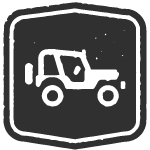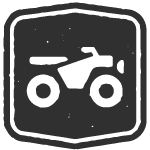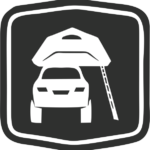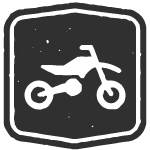
Camping


Whenever possible, use existing campsites. Camp on durable surfaces and place tents on a non-vegetated area. Do not dig trenches around tents.
TOP 10 WAYS TO MINIMIZE IMPACT WHEN CAMPING IN THE OUTDOORS
- Whenever possible, use existing campsites. Camp on durable surfaces and place tents on a non-vegetated area. Do not dig trenches around tents.
- Camp a least 200 feet from water and other campsites. In backcountry areas not open to vehicles, camp at least 200 feet from trails.
- Pack out what you pack in. Carry a trash bag and pick up litter left by others.
- Repackage snacks and food in baggies. This reduces weight and the amount of trash to carry out.
- For cooking, consider using a camp stove instead of a campfire. Camp stoves leave less of an impact on the land.
- Observe all fire restrictions. If you must build a fire—use existing fire rings, build a mound fire, or use a fire pan. Use only fallen timber for campfires. Do not cut standing trees. Clear a 10-foot diameter area around the site by removing any grass, twigs, leaves and extra firewood. Also make sure there aren’t any tree limbs or flammable objects hanging overhead.
- Allow the wood to burn down to a fine ash, if possible. Pour water on the fire and drown all embers until the hissing sound stops. Stir the campfire ashes and embers until everything is wet and cold to the touch. If you don’t have water, use dirt.
- Detergents, toothpaste and soap harm fish and other aquatic life. Wash 200 feet away from streams and lakes. Scatter gray water so it filters through the soil.
- In areas without toilets, use a portable latrine if possible, and pack out your waste. If you don’t have a portable latrine, you may need to bury your waste. Human waste should be disposed of in a shallow hole six to eight inches deep at least 200 feet from water sources, campsites or trails. Cover and disguise the hole with natural materials. It is recommended to pack out your toilet paper. High use areas may have other restrictions, so check with a land manager.
- Following a trip, wash your gear and support vehicle to reduce the spread of invasive species.
TREAD LIGHTLY!’S TIPS FOR RESPONSIBLE CAMPING
Minimizing your impact on the environment when camping is critical. Below are more tips to tread lightly when traveling to your destination, selecting your site, and leaving it better than you found it. To view this information in a brochure format Click Here
TRAVEL RESPONSIBLY
Travel responsibly on designated roads, trails or areas.
- While traveling to your favorite camping spot, stay on designated roads and trails.
- Always practice minimum impact travel techniques for your mode of transportation.
- Go over obstacles, not around. Don’t create new routes or expand existing trails.
- Cross streams only at fords where the road or trail crosses the stream.
- If hiking on a trail, walk single file to avoid widening the trail.
- If there are no trails and hiking is permitted, spread out in open country. Spreading out, rather than following each other’s footsteps, disperses impact and avoids creating a new trail.
- If possible, travel on hardened surfaces such as gravel, rock or in sand washes.
- Comply with all signs and respect barriers.
- Buddy up with two or three campers, reducing vulnerability if you have an accident or breakdown.
RESPECT THE RIGHTS OF OTHERS
Whenever possible, use existing campsites. Camp on durable surfaces and place tents on a non-vegetated area. Do not dig trenches around tents.
Respect the rights of others, including private property owners, all recreational trail users, campers and others so they can enjoy their recreational activities undisturbed.
- Be considerate of others on the road, trail and campground. Learn the basics of trail etiquette.
- Keep noise to a minimum especially in the early morning and evening hours.
- Be considerate of other campers’ privacy, keep your distance and avoid traveling through their campsites.
- Camping supplies in natural colors blend with natural surroundings and are less intrusive to other campers’ experiences.
- Leave gates as you find them. If crossing private property, be sure to ask permission from the landowner(s).
- Proceed with caution around horses and pack animals. Sudden, unfamiliar activity may spook animals possibly causing injury to animals, handlers and others on the trail.
EDUCATE YOURSELF
Educate yourself prior to a trip by obtaining travel maps and regulations from public agencies, planning for your trip, taking recreation skills classes, and knowing how to operate your equipment safely.
- Obtain a map (motor vehicle use map where appropriate) of your destination and determine which areas are open to your type of travel.
- Make a realistic plan and stick to it. Always tell someone of your travel plans.
- Contact the land manager for area restrictions, closures, and permit requirements.
- Check the weather forecast for your destination. Plan clothing, equipment and supplies accordingly.
- Carry a compass or a Global Positioning System (GPS) unit and know how to use it.
- Prepare for the unexpected by packing emergency items.
AVOID SENSITIVE AREAS
Avoid sensitive areas such as meadows, lakeshores, wetlands and streams. Stay on designated routes.
- Other sensitive habitats to avoid, unless on designated routes, include cryptobiotic soils of the desert, tundra, and seasonal nesting or breeding areas.
- Do not disturb historical, archeological, or paleontological sites.
- Avoid “spooking” livestock and wildlife you encounter and keep your distance.
- Motorized and mechanized vehicles are not allowed in designated Wilderness Areas. (What are Wilderness Areas?)
DO YOUR PART
Do your part by modeling appropriate behavior, leaving the area better than you found it, properly disposing of waste, minimizing the use of fire, avoiding the spread of invasive species and restoring degraded areas.
- Pack out what you pack in. Carry a trash bag and pick up litter left by others. Repackage snacks and food in baggies. This reduces weight and the amount of trash to carry out.
- Whenever possible, use existing campsites. Camp on durable surfaces and place tents on a non-vegetated area. Do not dig trenches around tents.
- Camp at least 200 feet from water and other campsites.
- In backcountry areas not open to vehicles, camp at least 200 feet from trails.
- For cooking, use a camp stove. They are always preferable to a campfire in terms of impact on the land.
- Observe all fire restrictions. If you must build a fire, use existing fire rings, build a mound fire or use a fire pan. For campfires, use only fallen timber. Gather firewood well away from your camp. Do not cut standing trees. Let your fire burn down to a fine ash. Ensure your fire is completely extinguished.
- Do not wash in streams and lakes. Detergents, toothpaste and soap harm fish and other aquatic life. Wash 200 feet away from streams and lakes. Scatter wash water so it filters through the soil.
- In areas without toilets, use a portable latrine if possible and pack out your waste, otherwise it’s necessary to bury your waste. Human waste should be disposed of in a shallow hole (6”-8” deep) at least 200 feet from water sources, campsites or trails. Cover and disguise the hole with natural materials. Pack out your toilet paper.
- High-use areas may have other restrictions so check with a land manager.
- Take a small bag and pack out your pet’s waste– especially in front-country areas or on or near trails or trailheads.
- Before and after a trip, wash your gear and support vehicle to reduce the spread of invasive species.














